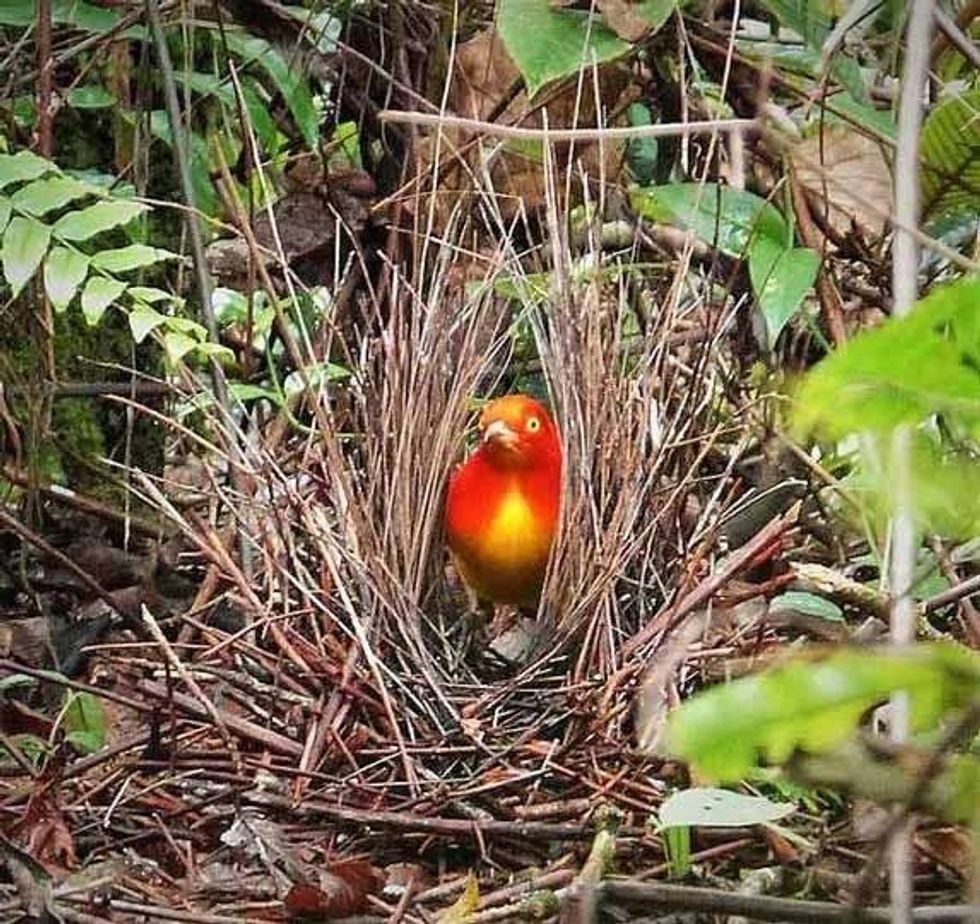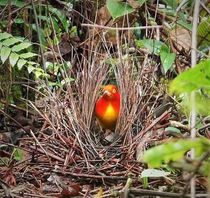Among the bird species, there is one that is quite interesting to earn about which is known as the flame bowerbird, Sericulus ardens. It has a body color that looks like fire, and it is a species of the bowerbird.
Out of 20 different bowerbird species, the flame bowerbird is one among them. This bird is considered to be one of the most beautiful, with its brilliant color. They are highly distinguishable from other bird species with the unique colors they have acquired.
They are mostly found in the rainforests of New Guinea, and in some parts of Australia. You won't have any trouble spotting or finding this particular bowerbird species because their population is stable at the moment.
The males' courtship performance to impress and attract the females flame bowerbird for breeding, is truly a sight. There are a lot of differences between the males and females of this bird species physically.
The males are more colorful than the females. The flame bowerbird nest on trees, far above the ground.
Since their dance is appealing, some of the tribes in the jungle use the birds' movement as their dance and decorate their bodies to mimic the flame bowerbird's appearance. The flame bowerbird sericulus aureus, is one of the favorites of bird-watchers.
It can get quite interesting to know and learn about birds, so read on for more about the flame bowerbird, Sericulus ardens. You may also want to check out birds of paradise and barn owl too.
Flame Bowerbird Interesting Facts
What type of animal is a Flame Bowerbird?
The flame bowerbird sericulus aureus is a type of bowerbird species, also known as Sericulus ardens.
What class of animal does a Flame Bowerbird belong to?
The flame bowerbird, sericulus ardens, belongs to the Aves class of animals.
How many Flame Bowerbirds are there in the world?
The number of the flame bowerbird (Sericulus ardens) present across the world is unknown.
Where does a Flame Bowerbird live?
The flame bowerbird sericulus aureus lives in a nest, on trees build by laying soft materials, such as ferns, vine tendrils, leaves, and sidewalls of sticks.
What is a Flame Bowerbird's habitat?
The habitat of flame bowerbird, are endemic to the rainforests of New Guinea. Some of the flame bowerbird cites in Australia also.
This bird species can be found in the lowland and foothill rainforest, including tall secondary forests. Some species of bowers' habitat were also on gently sloping ground in foothill forest, tall secondary forest, and swamp forest, with sparse slender and undergrowth trees where some are adjacent to a fallen tree.
Who do Flame Bowerbirds live with?
The flame bowerbird sericulus aureus is generally known to live by itself, as a solitary bird.
How long does a Flame Bowerbird live?
The flame bowerbird sericulus aureus has an average lifespan of 20-30 years.
How do they reproduce?
The flame bowerbird sericulus aureus are known to be one of the most attractive birds that release its amazing colors when it performs courtship when breeding.
The male flame bowerbird has strong instincts to choose the right mate for themselves, but they participate in polygynandry where they mate with several females.
The male uses their best efforts to build an appealing nest and decorate their bower with things that have the same color.
When the female enters its nest, the male performs a courtship and uses every part of his body with intriguing colors to attract the female.
The flame bowerbird dance is more than just a way to flirt with the females, as this performance is also a chance for females to evaluate their soon-to-be mate.
During the performance, another male could come and ruin the performance by stealing the female, but such an incident wouldn't happen if the male is truly capable of impressing the female bowerbird.
When the female bowerbird conceives, it moves somewhere else to build its nest for laying eggs, where they can lay up to three eggs, and then she would lay and hatch the eggs all by herself.
During this phase, the male bowerbird might seduce another female flame bowerbird and mate with them, which is a common trait of the males to have more than one mating partner.
The breeding or reproduction process of the flame bowerbird sericulus aureus is considered to be unique and full of art.
What is their conservation status?
The flame bowerbird, Sericulus ardens, has a conservation status of Least Concern.
Flame Bowerbird Fun Facts
What do Flame Bowerbirds look like?
The flame bowerbird, Sericulus ardens, also known as golden bowerbird is the most brilliantly colored among the bowerbird species. These birds are stout, typically heavy-billed, and strong footed birds that tend to stay on low grounds.
Male flame bowerbird facts include that it is more colorful than the females. The male is a medium-sized bird and can reach 9.8 in (25 cm) in length.
It has flame orange, golden, yellow plumage, along with neck plumes which are elongated, and a black tail with its tip being yellow. The females are also the same size as the male, but the female is an olive-brown bird, with yellow or golden stomach.
What the male and female bowerbirds have in common are the yellow or golden color distribution on their body. These birds are endemic to the rainforests of New Guinea.
How cute are they?
These birds, with their colorful and appealing plumage are cute to watch and be admired.
How do they communicate?
The flame bowerbird, Sericulus ardens, have a wide range of vocalization, while some utter harsh, loud noted or hiss, chatter and cackle. They also make other birds calls, different sounds from their environment, and sometimes even human-made sounds. The male Sericulus ardens are known to make constant sounds while breeding or during the process of courtship.
How big is a Flame Bowerbird?
The flame bowerbird, Sericulus ardens, are 10 times bigger than house sparrows which are only 20-40 g.
How fast can a Flame Bowerbird fly?
The flying speed of these bowerbird species is unknown. Bowerbirds are generally confined to lower grounds for their habitat or foraging, but the flame bowerbird, Sericulus ardens, nests on trees that are slightly higher from the ground compared to other bowerbird species.
How much does a Flame Bowerbird weigh?
The weight of the flame bowerbird range between 120-168 g, and is a medium-sized bird.
What are their male and female names of the species?
There are no other names used to describe the male and female Sericulus ardens. However, due to their color differences, the females are known as an olive-brown bird with yellow stomach, and males are commonly known as flame orange and golden bowerbird.
What would you call a baby Flame Bowerbird?
A baby flame bowerbird, Sericulus ardens, is known as a chick or simply baby bowerbird.
What do they eat?
As a carnivorous bird, the flame bowerbird, Sericulus ardens, diet contains insects, fruits, seeds, spiders, and so on.
Are they dangerous?
No, this bird species pose no harm to humans, as they are quite friendly and if raised as a pet, would even try to mimic human sounds.
Would they make a good pet?
The flame bowerbird, Sericulus ardens, are friendly birds that would make a great pet if given good care.
Did you know...
This bird builds an avenue type nest with two side walls of sticks.
The flame bowerbird, Sericulus ardens, have diluting yellow eyes with black pupils.
The flame bowerbird is pronounced as FLA-AM BA-WER-BIRD.
What is unique about Flame Bowerbirds?
The mesmerizing courtship performed by the male flame bowerbird is what makes this colorful bird unique from the rest.
What is the bower of the Flame Bowerbirds?
A bower generally means a shady, pleasant place under a tree or climbing plants in the woods or garden. In the case of bowerbirds, bower comes from the fact that during the breeding season, the males build a display ground that resembles a bower.
Here at Kidadl, we have carefully created lots of interesting family-friendly animal facts for everyone to discover! Learn more about some other birds including the secretary bird, or great green macaw.
You can even occupy yourself at home by drawing one on our Flame Bowerbird coloring pages.










